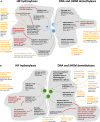Vitamin C and immune cell function in inflammation and cancer
- PMID: 30301842
- PMCID: PMC6195639
- DOI: 10.1042/BST20180169
Vitamin C and immune cell function in inflammation and cancer
Abstract
Vitamin C (ascorbate) is maintained at high levels in most immune cells and can affect many aspects of the immune response. Intracellular levels generally respond to variations in plasma ascorbate availability, and a combination of inadequate intake and increased turnover during severe stress can result in low plasma ascorbate status. Intracellular ascorbate supports essential functions and, in particular, acts as an enzyme cofactor for Fe- or Cu-containing oxygenases. Newly discovered enzymes in this family regulate cell metabolism and epigenetics, and dysregulation of their activity can affect cell phenotype, growth and survival pathways, and stem cell phenotype. This brief overview details some of the recent advances in our understanding of how ascorbate availability can affect the hydroxylases controlling the hypoxic response and the DNA and histone demethylases. These processes play important roles in the regulation of the immune system, altering cell survival pathways, metabolism and functions.
Keywords: ascorbate; demethylation; hydroxylases; hypoxia inducible factors; vitamin C.
© 2018 The Author(s).
Conflict of interest statement
The Authors declare that there are no competing interests associated with the manuscript.
Figures

References
-
- Sauberlich, H.E. (1997) A history of scurvy and vitamin C In Vitamin C in health and disease, 1st edn. (Packer L. and Fuchs J., eds), pp. 1–24, Marcel Dekker, Inc., New York
-
- Bergsten P., Amitai G., Kehrl J., Dhariwal K.R., Klein H.G. and Levine M. (1990) Millimolar concentrations of ascorbic acid in purified human mononuclear leukocytes. Depletion and reaccumulation. J. Biol. Chem. 265, 2584–2587 PMID: - PubMed
Publication types
MeSH terms
Substances
LinkOut - more resources
Full Text Sources
Other Literature Sources
Medical

